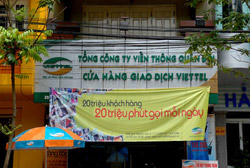INDOCHINA INTERNATIONAL CONSULTING CO., LTD
HO Add: 62L/36 Nguyên Hồng, Ward 11, Bình Thạnh District, HCMC - Vietnam
Biz Office Add: #48 Road No 11, Quarter 6, Hiệp Binh Chánh Ward, Thủ Đức, HCMC - Vietnam
®Source: http://viipip.com should be clearly quoted for any use of information extracted from our website.
Publication permit No: 60/GP-TTĐT , April 05, 2010.


Viettel’s promotional programme for November 2008.
By the end of October 2008, Vietnam had around 80 million mobile subscribers, nearly 80 times more than 14 years ago. In 1994, when the country had only one mobile service provider – MobiFone – the number of mobile users was less than one million.
Now, with seven mobile networks in the market, the mobile service business is brutally competitive. To get new subscribers, service providers have to invent all kinds of promotional measures. According to the Ministry of Information and Communications, promotional campaigns are being introduced every day.
The number of subscribers is rocketing as service providers are offering super-low price service packages. Mobile phones have become a popular device for everybody and many people have at least two mobile phone numbers.
Yet, the robust growth of subscribers hasn’t helped mobile service providers earn more money. Because of the endless promotional campaigns, charges have fallen, leading to a serious decrease in average revenue per user (ARPU).
In 2005, the average ARPU of local mobile networks was $16/subscriber/month. At present, the figure is around $7.5/subscriber/month. When service providers launch big promotional campaigns, it is less than $5.
Le Ngoc Minh, Director of VMS-MobiFone, admitted that brutal competition among mobile networks has pulled charges down. Though the number of subscribers is rising, ARPUs are falling.
“ARPUs have been falling owing to the popularisation of mobile services. In the past, MobiFone aimed to attract high-income customers but now the number of low-income customers is increasing,” Minh said.
MobiFone’s current ARPU is about $7/subscriber/month. This sum is $5 less per subscriber compared to last year and $8 less than three years ago.
The reason is the majority of new users are low-income earners while MobiFone has to launch many promotional campaigns to get these users. MobiFone currently has some service packages for low-income earners like MobiQ for students and Mobi365 for rural users.
Other mobile networks such as VinaPhone, S-Fone and Viettel are experiencing the same thing. One year ago, Viettel’s ARPU was $15 and now it is $10 or even $6 if spending for promotional campaigns is deducted. The figure is even lower for VinaPhone, at $4 only.
Last year Viettel earned revenue of VND12 trillion ($750 million), including VND3 trillion in profit and VND3-VND3.6 trillion spent on promotional campaigns. VinaPhone and MobiFone are said to have spent a similar amount of money on trade promotions.
According to some experts, by launching special promotional programmes, for example giving bonus money to subscribers, sometimes service providers spend VND1,000 in trade promotion to obtain VND500 of revenue. Viettel presently has around 20 million subscribers and MobiFone around 15 million. If Viettel presents bonus money of VND10,000 to each subscriber, it will have to pay VND200 billion ($12.5 million). In fact, the bonus money is often VND20,000-30,000 or even hundreds of thousands of dong.
Experts have warned that if mobile networks don’t seek to improve their ARPUs, their revenue will fall even more dramatically when the market reaches its saturation point.
Viettel said a high ARPU is the ambition of all mobile networks but their priority is attracting new subscribers and improving service quality. So they have to reduce charges and launch promotion programmes. Viettel’s current business strategy is increasing revenue by increasing the number of subscribers. Though its ARPU has decreased remarkably in the past two years, Viettel is still operating at a profit.
This year, MobiFone aims to earn VND17 trillion in revenue, VND3 trillion over last year. Viettel has set the goal of VND23 trillion in revenue compared to VND12 trillion last year.
Revenue from a subscriber varies depending on voice, messaging, and value-added services like music, video and game download, news, Internet access, etc. The revenue from voice and messaging service seems to not increase because the charges are decreasing. Service providers expect to earn more from value-added services so they all want to get a 3G licence. 3G technology is considered the most effective technology for developing value-added services.
Seven mobile networks are now competing for four 3G licences. The results will be announced next year.
- FDI capital continues to pour into Vietnam (6/11/2025 1:20:33 PM)
- Thanh Hoa receives good news: Preparing to have an additional industrial park of up to 470 hectares, creating jobs for nearly 30,000 people (6/11/2025 1:15:09 PM)
- Industrial Park Real Estate: Waiting for the New Generation of FDI (6/11/2025 1:10:15 PM)
- A wealthy Vietnamese city will have two special economic zones after the merger (6/11/2025 1:04:42 PM)
- 30 billion USD capital FDI in Việt Nam by 2025, a series of "ông big" races to expand the land fund (6/11/2025 12:55:26 PM)
- the 2nd largest city in the North will start construction on an international economic zone (6/11/2025 12:50:20 PM)
- Japanese giant Sumitomo continues to want to build an industrial park in the countrys fourth smallest province. (6/11/2025 12:40:45 PM)
- 3 foreign corporations want to invest billions of dollars in Ba Ria - Vung Tau (6/11/2025 12:34:30 PM)
- Lotte Group member starts construction of nearly 1,000 billion VND logistics center in the province with the most industrial parks in Vietnam (6/11/2025 12:33:26 PM)
- Forming a regional center for manufacturing spare parts and components (6/11/2025 12:24:08 PM)
- Vietnams first wafer factory is about to start construction (6/11/2025 12:19:09 PM)
- Dong Nai attracts foreign investors (6/11/2025 12:13:27 PM)
- Tay Ninhs largest industrial park welcomes a $150 million high-end knitted fabric factory project (6/11/2025 12:11:00 PM)
- (6/11/2025 12:09:10 PM)
- Vietnam will become a destination for Chinese investors in the future (11/6/2023 1:03:19 PM)

- FDI capital continues to pour into Vietnam
- Thanh Hoa receives good news: Preparing to have an additional industrial park of up to 470 hectares, creating jobs for nearly 30,000 people
- Industrial Park Real Estate: Waiting for the New Generation of FDI
- A wealthy Vietnamese city will have two special economic zones after the merger
- 30 billion USD capital FDI in Việt Nam by 2025, a series of "ông big" races to expand the land fund










 ADB: Vietnam’s 2009 GDP growth to be highest in South East Asia
ADB: Vietnam’s 2009 GDP growth to be highest in South East Asia MGM Grand Ho Tram: Vietnam’s First ‘Las Vegas Style’ Integrated Resort
MGM Grand Ho Tram: Vietnam’s First ‘Las Vegas Style’ Integrated Resort Nha Trang’s Twin Towers project licenced
Nha Trang’s Twin Towers project licenced Foreign investors still have good opportunities in Vietnam
Foreign investors still have good opportunities in Vietnam Sierra Wireless gets a foot in Vietnam’s ICT market
Sierra Wireless gets a foot in Vietnam’s ICT market